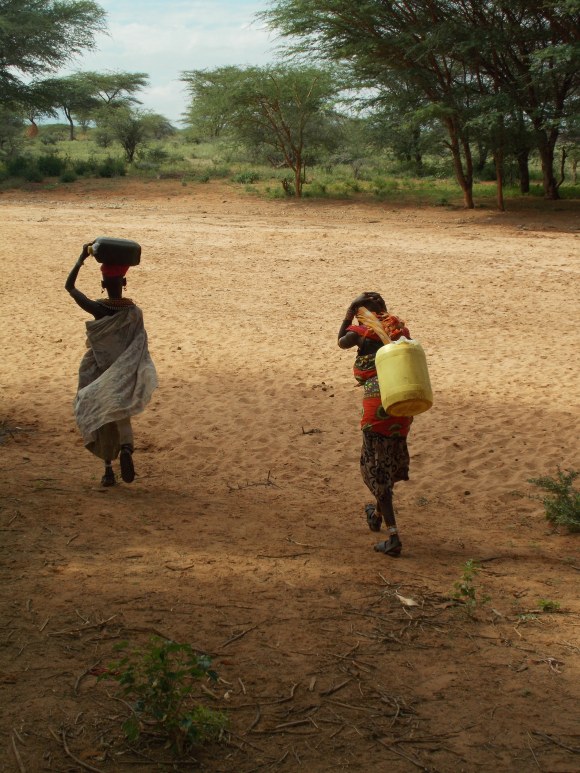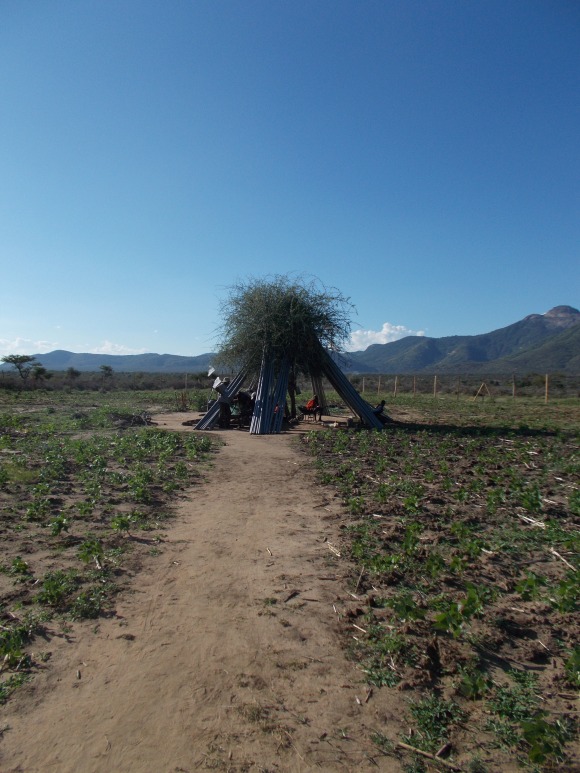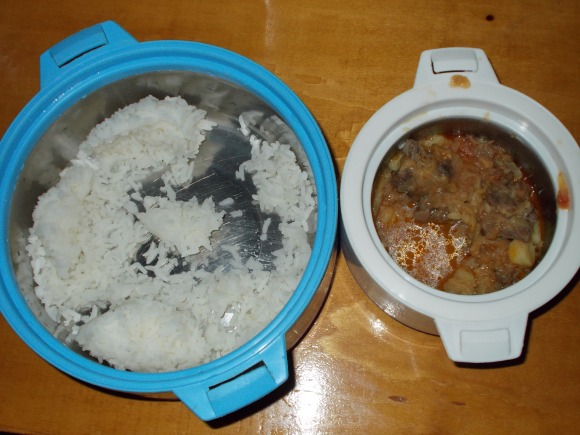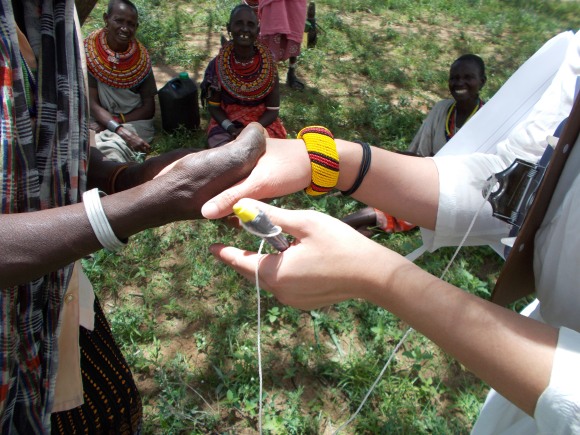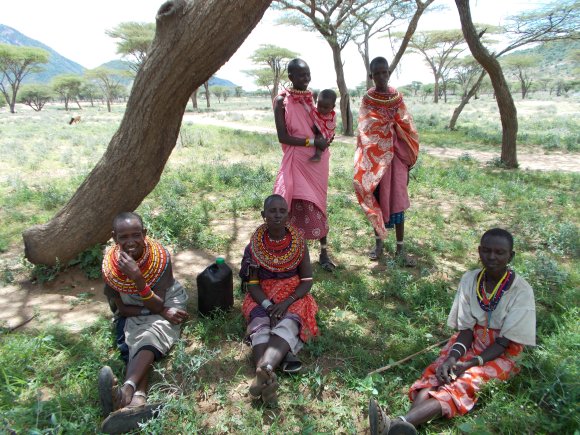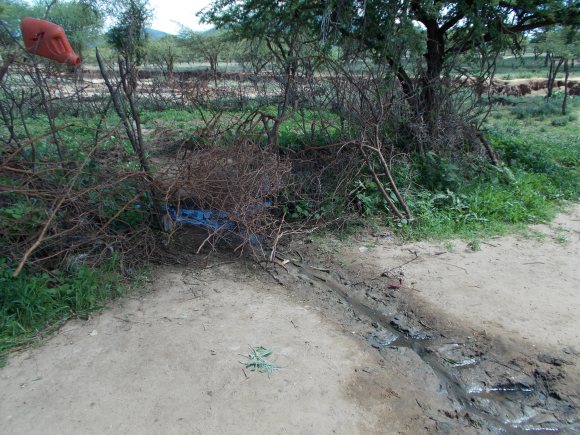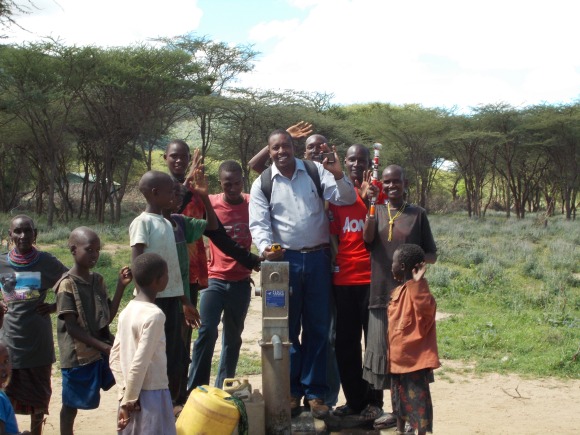On Wednesday, Lucas, Paul and I meant business as we traveled to 8 wells!

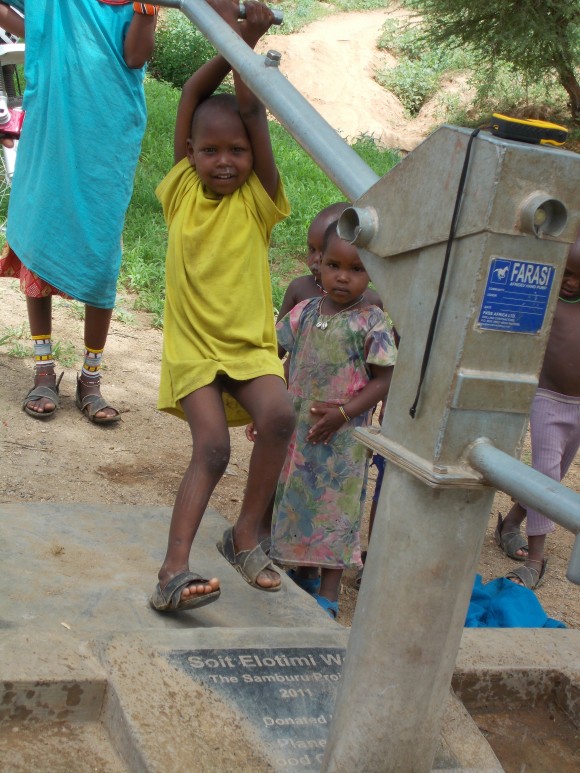
After the second well, I was already beginning to feel a little fatigued from the sun and the traveling (which Lucas was quick to pick up on) but when we spotted the third well, any tiredness or lethargy I may have been feeling up to that point dissipated. As we pulled up to Lbaa Onyokie 1 Well (D3W9), Lucas revealed that this was one of the wells where all the hardware (pipes, rods, rubbers, hand pump) were removed by another organization called ACTED at the end of last year.
Early in January of this year, Kristen received an alarming report from Lucas and Juma that two of our wells had been meddled with a couple weeks prior. These people, who were not Samburu, came on a Thursday which is the big market day in Samburu East District. Everybody from all the communities go either to town or the livestock market –it takes them 2 to 3 hours to travel one way from their homes to the market! Now that women no longer have to spend their entire day looking for water, they now have time and energy to go to the market and trade their livestock or sell their beadwork in order to earn money to buy food or other necessary items for their family. As a result, there are no adults at the well during midday Thursday (which is why Lucas and I are working in the office right now!). These people came and took all of the hardware and left the well broken and completely unusable. There were a few children nearby that spotted the big blue car and witnessed the incident. When the community found out later that afternoon what had happened, they frantically sent someone to inform Lucas or Paul about the dire situation. This same thing happened to a second one of our wells, Lbaa lo Ltepes 2 (D4W5) and they too immediately went to find Lucas.
After some investigation, Lucas found out that these people were from the organization called ACTED. ACTED had recently expanded their operations to Samburu and had been surveying the area. They must have come across several of our wells but when they stopped by these two particular wells, they found Lbaa Onyokie 1 not pumping at the optimal rate and Lbaa lo Ltepes 2 not pumping water at all. At that time, Paul had been working on the former well and was finishing up the repairs. As for the latter well, Paul had visited this community a week prior to the breakage and therefore had no reason to believe that there would be an issue before next month’s visit. Again, it takes a few days for news of a problem to reach Lucas or Paul since these communities do not have cell phones and it takes them at least half a day to come into town and have a meeting. Because of the difficulty in communication, Lucas believes that the well was inoperative for about a week. However, once Paul learnt of the problem he began mobilizing a team to go out there and fix the issue. Therefore, whereas Lucas and Paul were fully aware of the situation and were working hard to remedy the problem, the ACTED team probably saw two wells that had been abandoned and in need of being “rescued”. Unfortunately they did no such thing. The wells were left disassembled and inoperable for several months. Moreover as far as I know, ACTED did not communicate with the well community and let them know what their goals were or their timeline for “fixing” this well. Imagine how the communities must have felt to have this precious resource given to them only to be taken away for an indefinite time. Regrettably, ACTED’s actions did not benefit the community- instead it left the community without water and made them distrust outsiders.
Lucas worked tirelessly to get to the bottom of this and after a series of meetings with the ACTED personnel was able to get them to return the parts and flush out the well of any contaminates that may have fallen through during those months that the well was left exposed. Before my visit, both the wells were in working condition again and Lucas had personally visited the sites to see for himself.
Which brings us back to our visit yesterday.
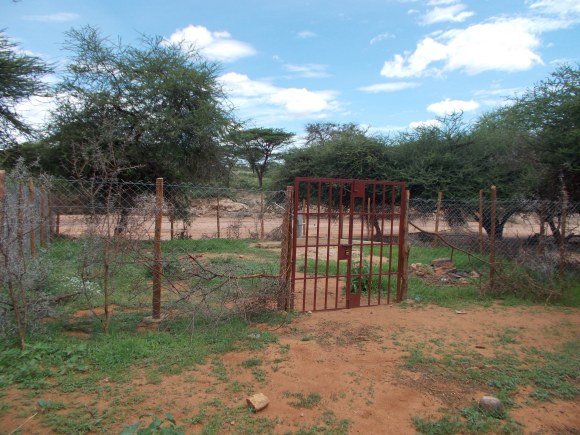
Unlike anything I have seen so far in my visits, this well is encircled by chain link fencing at least six feet tall and there was a padlocked gate in the front that was locked, preventing anyone from entering into the well area. On the one hand, the gate was very impressive and is probably what Kristen envisions for every well. As part of our agreement with the well committee during the mobilization phase, the community is responsible for putting up a fence around the well in order to protect it from any destruction or contamination. In particular, the fence serves to keep the livestock from trampling on the slab foundation and potentially contaminating the well. One of the challenges that communities face when putting up the well is that regardless of whether it is chain fencing (preferred but expensive for the community) or bush fencing (branches, and thorny bushes), the fence often gets stolen by people passing through the area or swept away in a flood during the rainy season and needs to be replaced on a regular basis.
Below are some examples of the fencing around our wells:


Needless to say, this fence at Lbaa Onyokie 1 Well is a superb fence. The brick red metal gate in the front extends slightly higher than the fence and in theory should keep the livestock out while allowing easy entrance for people wishing to use the well. What shocked me however, was the fact that it was locked when we came, thereby preventing ANYONE from entering into the well area. Though Lucas has been in frequent communication with this community, this was the first time that he saw the gate and fence and he too was taken aback and disturbed that it was locked. He immediately had one of the boys that was looking at me inquisitively to summon the elders in the community and to get the key to unlock the gate.

Soon after, Mr. Lentoijoni (the far left in the picture below) joined us and was very gracious to tell the story again for my benefit. He informed us that the gate and padlock was given to them by ACTED in order to prevent the well from being vandalized again by outsiders. At this point, even Mr. Lentoijoni could recognize the frustration in my voice and I had Lucas clarify several times- did ACTED provide this gate to the community to prevent people such as themselves to tamper with the well? The answer was yes. The community had a meeting and agreed to keep the fence up and have the gate locked at night because they did not want it to be vandalized by outsiders; they were not worried about it being tampered by other Samburu communities, only by foreigners. As for the day time, the gate is usually kept unlocked. Mr. Loikurani, one of the men from the community (the one wearing the hat in the picture), is in charge of keeping the key and he sits next to the well during the day keeping an eye on it. When he has to be away from the well during the day, he locks up the gate. When we arrived, Mr. Loikurani had gone back to his home for lunch and that was why it was locked. However, everyone in the community knows that Mr. Loikurani has possession of the key and if the gate is locked when they want to use it, they know where to find him.
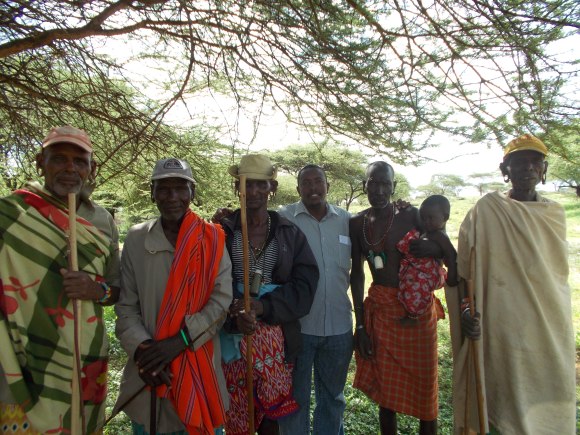
They will not let anyone that is not Samburu do anything to this well. If I had not come with Lucas, they would not have allowed me to change anything about the well and would have kept a very close eye on me. Mr. Lentoijoni was adamant in saying that they would not let anyone but Paul, Reuben or Juma come and do anything to this well from now on
Another elder named Mr. Lemedoro who was carrying a very cute baby conveyed his sentiments by telling a Samburu proverb: “Now we have really differentiated an eye of a cow and an eye of a buffalo.” Lucas explained to me that cows are very valued in this community. More than just a source of food and income for these people, cows represent hope for a better future. Buffalos on the other hand are deadly- they roam around and destroy everything in their way. In a similar way, the community likens us to a cow and have associated ACTED with the destruction that buffalos bring about.
Mr. Lentoijoni ended by expressing his personal appreciation and gratefulness to The Samburu Project because according to him, without The Samburu Project, this well probably would not have been fixed. He views us as dear friends and appreciates our regular visits. As were about to leave, all the elders began saying a blessing for us and praying over us; Lucas told me that they were blessing our work and asking God to go before us. Words can’t begin to describe how moved and touched I was by this gesture.
Now that the situation is behind us, I truly hope that, for the sake of the community and also for the sake of their standing with the Samburu people, ACTED will write a formal apology to the both communities and the district. Though I am glad that the community will not let something like this happen again, it pains me to see their distrust in people outside of their community which came as a result of this unfortunate event.

Ultimately it was not The Samburu Project that was harmed but rather the community. Though the gate and padlock is a nice gesture on behalf of ACTED, what the community needs is for ACTED to admit their wrongdoings, show remorse for making this community suffer for several months, and to ask forgiveness. No matter how big the organization or how much power it may have, at the end of the day every non-profit organization should be accountable to the people and work to serve them to the best of their ability.
 I felt great when I landed in Nairobi at 7 am thanks to the “No Jet Lag” remedy I picked up at Santa Monica Homeopathic Pharmacy. Lucas was waiting for me just outside baggage claim. Stepping out of the baggage hall is always exhilarating – even with limited sleep my senses all perked up to the sights, sounds and smells of Africa.
I felt great when I landed in Nairobi at 7 am thanks to the “No Jet Lag” remedy I picked up at Santa Monica Homeopathic Pharmacy. Lucas was waiting for me just outside baggage claim. Stepping out of the baggage hall is always exhilarating – even with limited sleep my senses all perked up to the sights, sounds and smells of Africa.


